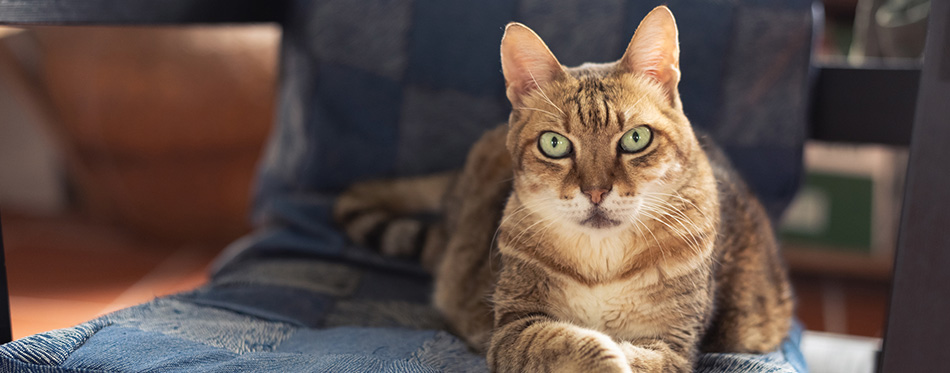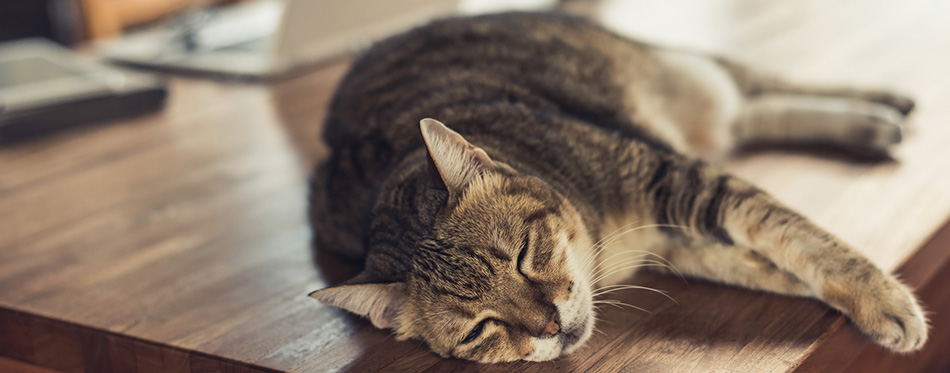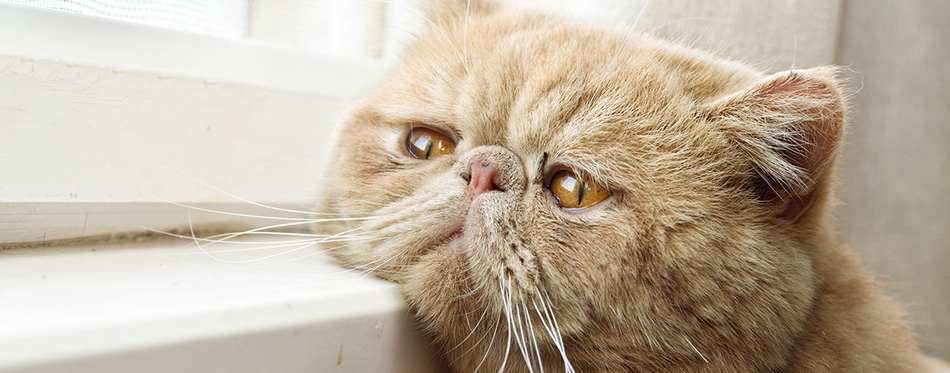The fact that cats are living longer than they did a few decades ago is a cause for celebration. This is largely due to our better understanding of feline nutrition and advances in veterinary care. These days, a cat is considered to reach the senior stage at the age of 11 years. Any cat that is aged between 11 and 14 years is defined as senior but once a cat reaches 15 years old they are classed as geriatric.
So, what are these equivalents in human years? This can be calculated using a simple formula. The first two years of a cat’s life are the same as 24 human years. Thereafter, every year in a cat’s life equates to four human years. Therefore, a 16 year old cat, who has just reached the geriatric stage, would be equivalent to an 80 year old human.

How Do Senior Cats Differ from Younger Cats?
To be able to properly look after your senior cat, it’s a good idea to learn all about the changes that they will experience as they age. Older cats have altered physiology, they experience changes in behavior and they become susceptible to certain health conditions and illnesses.
In terms of physiological changes, your senior cat may not be able to smell or taste food as well as they could before and this can result in a loss of appetite. Older kitties may also not be as able to digest fat and protein as efficiently as they did before so intestinal issues may arise. On top of this, senior felines cannot hear as well, their immune systems do not work as they used to, and their skin loses elasticity. They are also not able to tolerate stress as well as a younger cat can.
You may notice that their behavior changes and this can be a result of the physiological changes that they are experiencing. Your senior cat will hunt less and you may notice that they want to spend less time outside. Their activity levels decrease and they sleep more. Often, a senior cat will not groom themselves so much and will not be as keen on playing as they once were. They may also become more vocal, they feel less secure and will become more dependent on you.
If they develop a health condition, such as arthritis, it can trigger other behavior changes such as aggression which is associated with pain. Diabetes can trigger increased thirst or appetite.
Looking After Your Senior Cat
To make sure that your senior cat is happy and comfortable, there are plenty of things that you can do for them. Because they find it more difficult to look after themselves, you may need to be more involved in keeping them clean. You also need to keep a close eye on them so that you can quickly spot health issues.
- Claw trimming
Senior cats lose the ability to retract their claws and this is bad news for your carpets and sofas. They can also curl over and poke into your cat’s soft pads which can cause pain and injury. It can even become infected.
Therefore, you need to check your cat’s nails weekly. If they have grown long, they will need to be trimmed. If possible, learn how to do this yourself and invest in some good cat nail clippers. Your vet will be happy to do it for you but the journey to the vet could be stressful.
- Grooming
A young cat grooms themselves regularly to keep their eyes, nose and butt clean and to remove dead hairs from their coat. Senior cats cannot groom themselves so efficiently. This means that you will need to wipe away any discharge from their eyes, nose or bottom area using cotton wool moistened in warm water.
Once a week, brush your cat’s coat to remove dead hairs that they cannot remove themselves. This will keep their coat looking in good condition and it will enable you to spot any tangles that can become matted and may need to be cut out. The most common areas for these are the lower spine and hindquarters where an older cat cannot reach to groom. Severe matting needs to be dealt with by a vet.
You must use a soft brush for grooming your cat and you may need to use a fine comb occasionally. You must also proceed cautiously because older cats are usually thinner and will have protruding bones. It will hurt your cat if you hit these with a hard comb.
You may also like our article on the Best Flea Combs for Cats.
- Hairball prevention
Hairballs are more common in older cats. This is because they digest more hair as they are grooming and their digestion is slower so the hair can build up in the intestines. Hairballs can lead to digestive complications such as constipation and chronic vomiting. Find out more about cat food for constipation here.
You may find it helpful to switch to a cat food designed specifically for senior cats. It will have exactly the right combination of fiber in it to keep the digestion moving. It will also have omega oils to nourish the skin and reduce shedding so your cat will ingest less hair in the first place. For more options, check out our detailed review of cat food for hairballs.
- Toilet facilities
You may have gotten away with providing only outdoor toilet facilities for your younger cat but a senior cat will definitely need an indoor litter tray. An older cat will not be too keen on going outside in the cold and the rain for a poop or a pee. Place the litter tray well away from the food and water bowl. However, geriatric cats that have some cognitive dysfunction may need their bed, food bowl, water bowl and litter tray all in the same area because they can get confused. Do not get a covered litter tray because senior cats find these hard to get in and out of. Choose a sturdy tray that will not flip over – senior cats can be very clumsy. Don’t use polythene liners because your cat’s claws may get caught up in them.
Change the litter frequently to encourage your cat to use it. As you are changing the litter, you have an opportunity to check for changes in the poop or urine that could indicate a health problem. For an average adult cat, only about an inch of cat litter is necessary. However, for a senior cat that has a medical condition that causes increased urination, you may need a couple of inches.
Check out our guides on Cat Litter Mats and Cat Litter Box for more info.
- Dental health
Your senior cat’s teeth may be showing signs of wear and tear. You need to check your cat’s mouth regularly for signs of any lumps and bumps as well as reddening of the gums or any other evidence of dental disease.
Other signs of tooth or gum problems are halitosis (bad breath), drooling and a ‘chattering’ jaw. If you notice any of these or if your senior cat loses their appetite or paws at their mouth, you should get them checked out by your vet.

Dealing with a Loss of Appetite
As your cat gradually loses their sense of smell and taste, it is quite common for them to show less interest in food. You can’t really blame them! It is not unusual for senior cats to become malnourished. Luckily, there are plenty of things that you can do to stimulate their appetite and encourage them to eat.
- Feed small but frequent meals. Four to six meals a day would be suitable for an older cat. This will suit them better than a couple of big meals which they may find hard to digest.
- Feed them in a quiet area. You don’t want your cat to be disturbed once they have started to eat. Therefore, choose a quiet area of the house as their feeding area where they will not be disturbed by young children or other family pets.
- Vary their diet. You may need to try a few different foods to tempt them to eat. If they seem to be getting bored with their regular food, try another one. Find out more about senior cat food here.
- Change the bowl. It may be the bowl that is putting your senior cat off their food. You could consider swapping your old bowl for a wider bowl that is shallow.
- Raise the temperature. Senior cats may not be very keen on cold food so serving it straight from the fridge may not work. Try warming the food gently, this will give off more aromas and makes the food more palatable. Aim for a temperature that is just below body temperature.
- Vary the consistency. The consistency of the food is also important. Older cats who are having issues with their teeth or gums may not be able to cope with dry kibble or hard biscuits. They may prefer wet food. An alternative is to moisten dry food with a little warm water and mashing it up with a fork so that it has a paste consistency.
- Lift the food bowl. Older cats who have osteoarthritis of the neck or joint problems in the front limbs, may not be able to bend down to reach a food bowl on the floor. It would be worth investing in a raised bowl to make sure that they are comfortable as they are eating.
- Clear away uneaten food. Stale food is never tempting for a cat and can attract pathogens and insects. If your cat has not eaten the bowl of wet cat food within an hour of you putting it down, clear it away. Never add fresh food on the top – always start with a clean bowl.
- Try hand-feeding. If all else fails, you may have to resort to hand-feeding some tasty titbits to your senior cat to make sure that they are getting some nourishment.
Prevent Dehydration
All cats can get dehydrated and it can be a struggle to get them to drink enough water. The problem is even worse in older cats. And if they have a chronic medical condition, such as chronic kidney disease, the issue is even more serious.
There are several things that you can do to encourage your senior kitty to drink. Always make sure that they have a bowl of fresh water available. If you own a geriatric cat, you may need to have several bowls so that they can get to them without having to walk very far. One bowl should always be located by their food bowl and others can be placed around your home.
The material of the bowl is also important. Plastic bowls are not as popular with cats as metal and ceramic bowls because they can make the water smell and taste different. You may also have to experiment with different types of water. If your cat finds the tap water in your area unpalatable, you could switch to filtered water or even bottled spring water that you keep in the fridge. In hot weather, try adding a few ice cubes to the bowl to keep it cool. Raise the water bowl off the ground if your cat has problems crouching down. Drinking fountains are very popular with cats because they provide cool, running water and this is always a cat’s preference. In the wild, they like to drink from streams.
Related Post: Cat Food for Kidney Disease

Play Activities
Senior kitties still like to play! They may continue to enjoy their favorite toys or you may need to invest in some new ones. Larger toys encourage your cat to lie on their side to grab then with their front paws and kick them with their hind legs. This provides valuable exercise for their hind limbs which can get stiff. Toys that are rectangular or cylindrical and are around seven inches long and made from a durable fabric are ideal.
Don’t forget about cardboard boxes – cats love them! You may need to adapt one so that your senior cat can investigate it. Put the box on its side and perhaps but some scrunched up paper or a cat toy in there, and let your kitty explore it.
With a few simple adaptions, your senior cat can live an active and enjoyable life.
Sources:
- Caring for elderly cats – Cats Protection
- 6 Tips for Caring for Senior Cats – PetMD
- Loving Care for Older Cats – Cornell Feline Health Center

